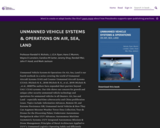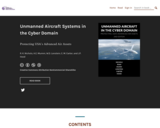
Short Description:
Unmanned Vehicle Systems & Operations On Air, Sea, Land is our fourth textbook in a series covering the world of Unmanned Aircraft Systems (UAS) and Counter Unmanned Aircraft Systems (CUAS). (Nichols R. K., 2018) (Nichols R. K., et al., 2019) (Nichols R. , et al., 2020)The authors have expanded their purview beyond UAS / CUAS systems. Our title shows our concern for growth and unique cyber security unmanned vehicle technology and operations for unmanned vehicles in all theaters: Air, Sea and Land – especially maritime cybersecurity and China proliferation issues. Topics include: Information Advances, Remote ID, and Extreme Persistence ISR; Unmanned Aerial Vehicles & How They Can Augment Mesonet Weather Tower Data Collection; Tour de Drones for the Discerning Palate; Underwater Autonomous Navigation & other UUV Advances; Autonomous Maritime Asymmetric Systems; UUV Integrated Autonomous Missions & Drone Management; Principles of Naval Architecture Applied to UUV’s; Unmanned Logistics Operating Safely and Efficiently Across Multiple Domains; Chinese Advances in Stealth UAV Penetration Path Planning in Combat Environment; UAS, the Fourth Amendment and Privacy; UV & Disinformation / Misinformation Channels; Chinese UAS Proliferation along New Silk Road Sea / Land Routes; Automaton, AI, Law, Ethics, Crossing the Machine – Human Barrier and Maritime Cybersecurity.Unmanned Vehicle Systems are an integral part of the US national critical infrastructure The authors have endeavored to bring a breadth and quality of information to the reader that is unparalleled in the unclassified sphere. Unmanned Vehicle (UV) Systems & Operations On Air, Sea, Land discusses state-of-the-art technology / issues facing U.S. UV system researchers / designers / manufacturers / testers. We trust our newest look at Unmanned Vehicles in Air, Sea, and Land will enrich our students and readers understanding of the purview of this wonderful technology we call UV.
Long Description:
Unmanned Vehicle Systems & Operations on Air, Sea & Land is the author’s fourth textbook in a series covering the world of Unmanned Aircraft Systems (UAS) and Counter Unmanned Aircraft Systems (CUAS). Unmanned Aircraft Systems in the Cyber Domain: Protecting USA’s Advanced Air Assets, 2nd edition and Counter Unmanned Aircraft Systems Technologies and Operations have seen considerable global recognition in the field. (Nichols R. , et al., 2019) (Nichols R. , et al., 2020) (Nichols R. K., 2018)
The authors have expanded our purview beyond UAS / CUAS systems. Our title shows our concern for growth and unique cyber security unmanned vehicle technology and operations for Unmanned Vehicles Systems in all theaters: Air, Sea and Land – especially maritime cybersecurity and China proliferation issues.
Three different factors have spurred the authors into expanding our textbook offerings. First, unmanned technology has seen an economic explosion in production, sales, testing, specialized designs, and friendly / hostile usages of deployed UAS / UAVs / Drones / UUVs / UDV / UGTs (hereafter referred to as a group as UVs). There is a huge global growing market and entrepreneurs know it. Small UV companies have been reproducing like rabbits. Many companies are exploring / creating new, unique, and profitable unmanned technologies for all military branches, LEO, commercial, high-mountain and deep-sea rescue, and recreational purposes. Covid-19 has brought a new dimension to UV planning and designs for medical and rescue missions.
Second, hostile use of UVs is on the forefront of DoD defense and offensive planners. They are especially concerned with SWARM behaviors in the air, over land and a new threat of underwater. The influence of IoT, AI and Cyber technologies has complicated the defense planning mission.
Third, UV technology has outpacing our first and second editions plus our textbook on CUAS. Everyday our writers group read / discussed new UAS / UV developments in navigation, weapons, surveillance, data transfer, fuel cells, stealth, weight distribution, tactics, GPS / GNSS ( and replacement technologies) elements, SCADA protections, privacy invasions, legislation, big-data usage, terrorist uses, cryptographic protections, pressure protection for deep water exploration, maintenance, rescue or intelligence gathering; ASW, and defense; specialized software and security protocols and more. As authors we felt compelled to address at least the edge of some of these new UV developments. It was clear that we would be lucky if we could cover some of the more interesting and priority technology updates for the various UV AOs.
Expanded purview means more experience was needed to write our newest work. We are privileged to add to original writing team of Nichols, Ryan, Mumm, Lonstein, Carter, and Hood new SMEs in the various UV technologies: Mai, Jackson, and Shay. Their extensive backgrounds are found in our tribute to the authors in a latter section.
Here is an outline of topics in our latest work:
SECTION 1: UNMANNED AIRCRAFT SYSTEMS
Chapter 1 Information Advances, Remote ID, & Extreme Persistence ISR [Ryan]
Chapter 2 : Unmanned Aerial Vehicles & How They Can Augment Mesonet Weather Tower Data Collection [Mai]
Chapter 3 Tour de Drones for the Discerning Palate [Nichols]
SECTION 2: UNMANNED UNDERWATER SYSTEMS
Chapter 4 Underwater Autonomous Navigation & other UUV Advances [Mumm]
Chapter 5 Autonomous Maritime Asymmetric Systems [Hood]
Chapter 6 UUV Integrated Autonomous Missions & Drone Management [Mumm]
Chapter 7 Principles of Naval Architecture Applied to UUV’s [Jackson]
SECTION 3: UNMANNED VEHICLES FOR GROUND / LAND OPERATIONS
Chapter 8 : Unmanned Logistics Operating Safely & Efficiently Across Multiple Domains [Lonstein]
Chapter 9 Chinese Advances in Stealth UAV Penetration Path Planning in Combat Environment [Nichols]
SECTION 4: UNMANNED VEHICLES WEAPONS FOR C4ISR & POPULATION TRACKING & CONTROL
Chapter 10 UAS, the Fourth Amendment and Privacy [Shay]
Chapter 11 UV & Disinformation / Misinformation Channels [Ryan]
SECTION 5: UV GEOPOLITICAL & LEGAL ADVANCES
Chapter 12 Chinese UAS Proliferation along New Silk Road Sea / Land Routes [Carter]
Chapter 13 Automaton, AI, Law, Ethics, Crossing the Machine – Human Barrier [Lonstein]
Chapter 14 Maritime Cybersecurity [Nichols]
Unmanned Vehicle Systems are an integral part of the US national critical infrastructure The authors have endeavored to bring a breadth and quality of information to the reader that is unparalleled in the unclassified sphere. Unmanned Vehicle (UV) Systems & Operations On Air, Sea, Land discusses state-of-the-art technology / defense issues facing U.S. UV system researchers / designers / manufacturers / testers.
We trust our newest look at Unmanned Vehicles in Air , Sea and Land will enrich our students and readers understanding of the purview of this wonderful technology we call UV.
Word Count: 105627
(Note: This resource's metadata has been created automatically by reformatting and/or combining the information that the author initially provided as part of a bulk import process.)
- Subject:
- Career and Technical Education
- Maritime Science
- Material Type:
- Textbook
- Provider:
- New Prairie Press
- Author:
- Candice M Carter
- Hans C Mumm
- J.J.C.H. Ryan
- Jeremy Shay
- John P. Hood
- Mark Jackson
- Randall K. Nichols
- Randall Mai
- Wayne D Lonstein
- Date Added:
- 01/26/2024

